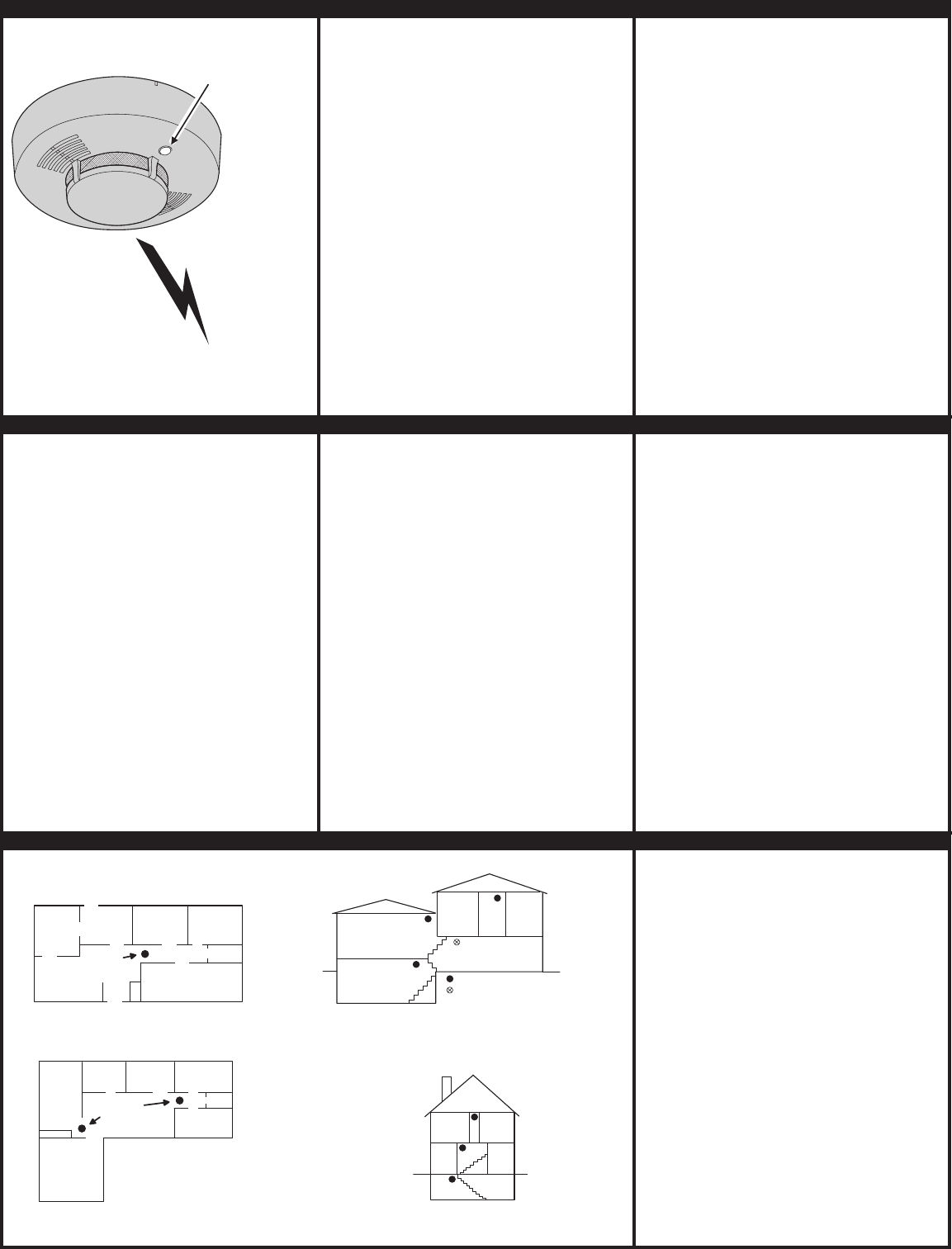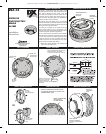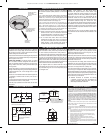
Copyright © 2006 Linear LLC 211669 F
TEST SYSTEM STANDARD FOR ALARM LOCATION
The DXT-72 should be installed in accordance with National
Fire Protection Association (NFPA) Standard 72, which reads
as follows:
2-1.1.1 Smoke alarms shall be installed outside of each separate
sleeping area in the immediate vicinity of the bedrooms and on each
additional story of the family living unit including basements and
excluding crawl spaces and unfi nished attics. In new construction, a
smoke alarm shall be installed in each sleeping room.
2-1.1.2 For family living units with one or more split levels (i.e.,
adjacent levels with less than one full story separation between
levels), a smoke alarm required by 2-1.1.1 shall suffi ce for an
adjacent lower level, including basements. (Exception: Where there
is an intervening door between one level and the adjacent lower
level, a smoke alarm shall be installed on the lower level.)
✔ Ceiling mounted smoke alarms should be located in the
center of the room or hall, or not less than 4 inches from
any wall. When the alarm is mounted on a wall, the top of
the alarm should be 4 to 12 inches from the ceiling.
✔ Do not install smoke alarms where normal ambient
temperatures are above 100°F (37.8°C), or below 40°F
(4°C). Also, do not locate alarm in front of air conditioners,
heating registers, or other locations where normal air
circulation will keep smoke from entering the detector.
A-2.5.2.1 Smoke Detection - Are More Smoke Alarms
Desirable? The required number of smoke alarms might
not provide reliable early warning protection for those areas
separated by a door from the areas protected by the required
smoke alarms. For this reason, it is recommended that the
householder consider the use of additional smoke alarms for
those areas for increased protection. The additional areas include
the basement, bedrooms, dining room, furnace room, utility
room, and hallways not protected by the required smoke alarms.
The installation of smoke alarms in kitchens, attics (fi nished or
unfi nished), or garages is not normally recommended, as these
locations occasionally experience conditions that can result in
improper operation.
Smoke alarms are not to be used with detector guards unless
the combination has been evaluated and found suitable for the
purpose.
The purpose of an early warning smoke alarm is to detect the
presence of fi re in its early stages, and sound an alarm giving
the occupants more time to exit the premise before the smoke
reaches a dangerous concentration level.
Fires start even with the best of housekeeping and fi re prevention
procedures. Fire is an unexpected event. Early warning detection
alerts occupants in time to act.
KNOW FIRE HAZARDS. No detection device can protect
life in all situations. Therefore, safeguards should be taken to
avoid such potentially dangerous situations as: smoking in bed,
leaving children home alone, cleaning with fl ammable liquids
such as gasoline.
The best fi re protection is minimizing fi re hazards through proper
storage of materials and general good housekeeping techniques.
A cluttered basement, attic, or other storage area is an open
invitation to fi re.
Careless use of combustible materials and electrical appliances,
or overloading of electrical outlets are other prime causes in
starting fi res.
It is most important that explosive and/or fast burning materials
be eliminated from the home, if at all possible.
Even after proper precautions have been taken, fi res can start.
Be prepared.
FIRE PREVENTION AND ESCAPE
IN CASE OF FIRE. Leave immediately. Don’t stop to pack or
search for valuables. In heavy smoke, hold your breath and stay
low - crawl if necessary. The clearest air is usually at the fl oor.
If you have to go through a closed door, carefully feel the door and
door knob to see if undue heat is present. If they seem relatively
cool, brace your foot against the bottom of the door with your
hip against the door and one hand against the top edge. Open it
slightly. If a rush of hot air is felt, slam the door quickly and latch
it. Unvented fi re tends to build up considerable pressure. Be sure
all the household realizes and understands this danger.
Use your neighbor’s phone or a street fi re alarm box. The job
of extinguishing the fi re should be left to the professionals. Too
many unforeseen things can occur when inexperienced people
try to extinguish a fi re.
BE PREPARED. Perform fi re drills regularly. Use them to assure
recognition of an alarm signal. For your protection, simulate
different circumstances (smoke in hall, in living room, etc.). Then
have everyone react to the situation.
Draw a fl oor plan and show two exits from each room. Frequently
a knotted rope or ladder from a window will serve this purpose.
It is important that children be instructed carefully, because they
tend to hide in times of crisis.
It is imperative that one meeting place outside the home be
established. You should insist that everyone meet there during
an alarm. This will eliminate the tragedy of someone re-entering
the house for a missing member who is actually safe.
If you have children and/or invalids residing in your household,
you can help your fi re department. Most fi re departments have
window decals available for use in children’s or invalid’s bedrooms.
Properly used, these decals will quickly identify sleeping quarters
of these individuals and show the fi re department where to look
fi rst for members of your household.
✔ Additional information on Household Fire Warning
is available at nominal cost from: The National Fire
Protection Association, Batterymarch Park, Quincy, MA
02269. Request Standard No. NFPA 72.
EXAMPLE ALARM LOCATIONS LINEAR LIMITED WARRANTY
This Linear product is warranted against defects in material and workmanship for
twelve (12) months. The Warranty Expiration Date is labeled on the product. This
warranty extends only to wholesale customers who buy direct from Linear or
through Linear’s normal distribution channels. Linear does not warrant this product
to consumers. Consumers should inquire from their selling dealer as to the nature
of the dealer’s warranty, if any. There are no obligations or liabilities on the part of
Linear LLC for consequential damages arising out of or in connection with use
or performance of this product or other indirect damages with respect to loss
of property, revenue, or profi t, or cost of removal, installation, or reinstallation.
All implied warranties, including implied warranties for merchantability and implied
warranties for fi tness, are valid only until Warranty Expiration Date as labeled on the
product. This Linear LLC Warranty is in lieu of all other warranties express or
implied.
All products returned for warranty service require a Return Product Authorization
Number (RPA#). Contact Linear Technical Services at 1-800-421-1587 for an RPA#
and other important details
IMPORTANT!!!
Linear radio controls provide a reliable communications link and fi ll an important need
in portable wireless signaling. However, there are some limitations which must be
observed.
✶ For U.S. installations only: The radios are required to comply with FCC Rules
and Regulations as Part 15 devices. As such, they have limited transmitter
power and therefore limited range.
✶ A receiver cannot respond to more than one transmitted signal at a time
and may be blocked by radio signals that occur on or near their operating
frequencies, regardless of code settings.
✶ Changes or modifi cations to the device may void FCC compliance.
✶ Infrequently used radio links should be tested regularly to protect against
undetected interference or fault.
✶ A general knowledge of radio and its vagaries should be gained prior to acting
as a wholesale distributor or dealer, and these facts should be communicated
to the ultimate users.
20 SECONDS AFTER
SOUNDER STARTS
TRANSMITTER WILL
SEND SIGNAL
VERIFY THAT
RECEIVER
ACTIVATES
PRESS AND HOLD
ALARM TEST
BUTTON FOR ONE
MINUTE
DINING
KITCHEN BEDROOM BEDROOM
BEDROOM
LIVING
ROOM
SMOKE
ALARM
A smoke alarm should be
located between the sleeping area
and the rest of the family living unit.
DINING KITCHEN BEDROOM
TV
ROOM
BEDROOM
LIVING
ROOM
BEDROOM
In family living units with more
than one sleeping area, a smoke
alarm should be provided to
protect each.
SMOKE
ALARMS
LIVING
ROOM
BASEMENT
HALL
BED
ROOM
BED
ROOM
Indicates required smoke alarm
Indicates optional smoke alarm
if door is not provided between
Living and Recreation Rooms
RECREATION ROOM
BASEMENT
HALL
BED
ROOM
BED
ROOM
LIVING
ROOM
DINING
ROOM
A smoke alarm should be
locatedoneachstory.
PRINTERS INSTRUCTIONS
INSTR,INSTL,DXT-72 SMOKE - P/N: 211669 F - INK: BLACK - MATERIAL: 20 LB. MEAD BOND - SIZE: 8.500” X 11.000” - SCALE: 1-1 - SIDE 2 of 2




